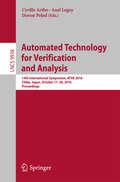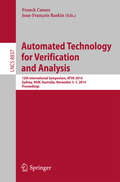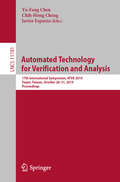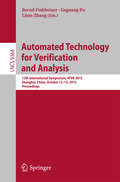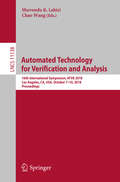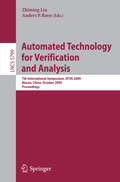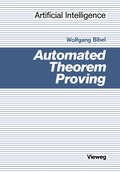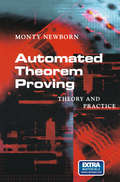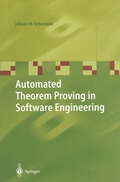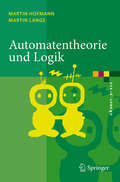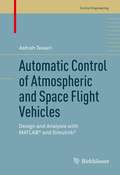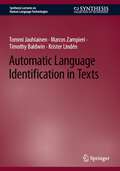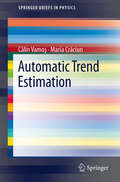- Table View
- List View
Automated Technology for Verification and Analysis: 14th International Symposium, ATVA 2016, Chiba, Japan, October 17-20, 2016, Proceedings (Lecture Notes in Computer Science #9938)
by Cyrille Artho Axel Legay Doron PeledThis book constitutes the proceedings of the 14th International Symposium on Automated Technology for Verification and Analysis, ATVA 2016, held in Chiba, Japan, in October 2016.The 31 papers presented in this volume were carefully reviewed and selected from 82 submissions. They were organized in topical sections named: keynote; Markov models, chains, and decision processes; counter systems, automata; parallelism, concurrency; complexity, decidability; synthesis, refinement; optimization, heuristics, partial-order reductions; solving procedures, model checking; and program analysis.
Automated Technology for Verification and Analysis: 12th International Symposium, ATVA 2014, Sydney, Australia, November 3-7, 2014, Proceedings (Lecture Notes in Computer Science #8837)
by Franck Cassez Jean-François RaskinThis book constitutes the proceedings of the 12th International Symposium on Automated Technology for Verification and Analysis, ATVA 2014, held in Sydney, Australia, in November 2014.The 29 revised papers presented in this volume were carefully reviewed and selected from 76 submissions. They show current research on theoretical and practical aspects of automated analysis, verification and synthesis by providing an international forum for interaction among the researchers in academia and industry.
Automated Technology for Verification and Analysis: 17th International Symposium, ATVA 2019, Taipei, Taiwan, October 28–31, 2019, Proceedings (Lecture Notes in Computer Science #11781)
by Yu-Fang Chen Chih-Hong Cheng Javier EsparzaThis book constitutes the refereed proceedings of the 17th International Symposium on Automated Technology for Verification and Analysis, ATVA 2019, held in Taipei, Taiwan in October 2019.The 24 regular papers presented together with 3 tool papers were carefully reviewed and selected from 65 submissions. The symposium is dedicated to the promotion of research on theoretical and practical aspects of automated analysis, verification and synthesis by providing a forum for interaction between the regional and the international research communities and industry in the field. The papers focus on cyber-physical systems; runtime techniques; testing; automata; synthesis; stochastic systems and model checking.
Automated Technology for Verification and Analysis: 13th International Symposium, ATVA 2015, Shanghai, China, October 12-15, 2015, Proceedings (Lecture Notes in Computer Science #9364)
by Bernd Finkbeiner Geguang Pu Lijun ZhangThis book constitutes the proceedings of the 13th International Symposium on Automated Technology for Verification and Analysis, ATVA 2015, held in Shanghai, China, in October 2015. The 27 revised papers presented together with 6 tool papers in this volume were carefully reviewed and selected from 95 submissions. They show current research on theoretical and practical aspects of automated analysis, verification and synthesis by providing an international forum for interaction among the researchers in academia and industry.
Automated Technology for Verification and Analysis: 16th International Symposium, ATVA 2018, Los Angeles, CA, USA, October 7-10, 2018, Proceedings (Lecture Notes in Computer Science #11138)
by Shuvendu K. Lahiri Chao WangThis book constitutes the refereed proceedings of the 24th International Symposium on Automated Technology for Verification and Analysis, ATVA 2018, held in Los Angeles, CA, USA in October 2018.The 27 full papers presented together with 5 short papers and 3 invited talks were carefully reviewed and selected from 82 submissions. The symposium is dedicated to the promotion of research on theoretical and practical aspects of automated analysis, verification and synthesis by providing a forum for interaction between the regional and the international research communities and industry in the field.
Automated Technology for Verification and Analysis: 7th International Symposium, ATVA 2009, Macao, China, October 14-16, 2009, Proceedings (Lecture Notes in Computer Science #5799)
by Zhiming Liu Anders P. RavnThis book constitutes the proceedings of the 7th International Symposium on Automated Technology for Verification and Analysis, ATVA 2009, held in Macao, China, in October 2009. The 23 regular papers and 3 took papers presented together with 3 invited talks, were carefully reviewed and selected from 74 research papers and 10 tool papers submissions. The papers are organized in topical sections on state space reduction, tools, probabilistic systems, medley, temporal logic, abstraction and refinement, and fault tolerant systems.
Automated Testing In Microsoft Dynamics 365 Business Central: Efficiently Automate Test Cases For Faster Development Cycles With Less Time Needed For Manual Testing
by Luc Van VugtEfficiently automate test cases for faster development cycles with less time needed for manual testing
Automated Theorem Proving (Künstliche Intelligenz)
by Wolfgang BibelSince both the coments and the structure of the book appeared to be successful, only minor changes were made. In particular, some recent work in ATP has been incorporated so that the book continues to reflect the state of the art in the field. The most significant change is in the quality of the layout including the removal of a number of inaccuracies and typing errors. R. Caferra, E. Eder, F. van der Linden, and J. Muller have caught vanous minor errors. P. Haddawy and S.T. Pope have provided many stilistic improvements of the English text. Last not least, A. Bentrup and W. Fischer have produced the beautiful layout. The extensive work of typesetting was financally supported within ESPRIT pro ject 415. Munchen, September 1986 W. Bibel PREFACE Among the dreams of mankind is the one dealing with the mechanization of human thought. As the world today has become so complex that humans apparently fail to manage it properly with their intellectual gifts, the realization of this dream might be regarded even as something like a necessity. On the other hand, the incredi ble advances in computer technology let it appear as a real possibility.
Automated Theorem Proving: Theory and Practice
by Monty NewbornThis text and software package introduces readers to automated theorem proving, while providing two approaches implemented as easy-to-use programs. These are semantic-tree theorem proving and resolution-refutation theorem proving. The early chapters introduce first-order predicate calculus, well-formed formulae, and their transformation to clauses. Then the author goes on to show how the two methods work and provides numerous examples for readers to try their hand at theorem-proving experiments. Each chapter comes with exercises designed to familiarise the readers with the ideas and with the software, and answers to many of the problems.
Automated Theorem Proving in Software Engineering
by Johann M. SchumannGrowing demands for the quality, safety, and security of software can only be satisfied by the rigorous application of formal methods during software design. This book methodically investigates the potential of first-order logic automated theorem provers for applications in software engineering. Illustrated by complete case studies on protocol verification, verification of security protocols, and logic-based software reuse, this book provides techniques for assessing the prover's capabilities and for selecting and developing an appropriate interface architecture.
Automated Theorem Proving: A Logical Basis (Fundamental Studies in Computer Science #1)
by D.W. LovelandAutomated Theorem Proving: A Logical Basis
Automated Theory Formation in Pure Mathematics (Distinguished Dissertations)
by Simon ColtonIn recent years, Artificial Intelligence researchers have largely focused their efforts on solving specific problems, with less emphasis on 'the big picture' - automating large scale tasks which require human-level intelligence to undertake. The subject of this book, automated theory formation in mathematics, is such a large scale task. Automated theory formation requires the invention of new concepts, the calculating of examples, the making of conjectures and the proving of theorems. This book, representing four years of PhD work by Dr. Simon Colton demonstrates how theory formation can be automated. Building on over 20 years of research into constructing an automated mathematician carried out in Professor Alan Bundy's mathematical reasoning group in Edinburgh, Dr. Colton has implemented the HR system as a solution to the problem of forming theories by computer. HR uses various pieces of mathematical software, including automated theorem provers, model generators and databases, to build a theory from the bare minimum of information - the axioms of a domain. The main application of this work has been mathematical discovery, and HR has had many successes. In particular, it has invented 20 new types of number of sufficient interest to be accepted into the Encyclopaedia of Integer Sequences, a repository of over 60,000 sequences contributed by many (human) mathematicians.
Automated Verification of Concurrent Search Structures (Synthesis Lectures on Computer Science)
by Krishna Siddharth Patel Nisarg Shasha Dennis Wies ThomasSearch structures support the fundamental data storage primitives on key-value pairs: insert a pair, delete by key, search by key, and update the value associated with a key. Concurrent search structures are parallel algorithms to speed access to search structures on multicore and distributed servers. These sophisticated algorithms perform fine-grained synchronization between threads, making them notoriously difficult to design correctly. Indeed, bugs have been found both in actual implementations and in the designs proposed by experts in peer-reviewed publications. The rapid development and deployment of these concurrent algorithms has resulted in a rift between the algorithms that can be verified by the state-of-the-art techniques and those being developed and used today. The goal of this book is to show how to bridge this gap in order to bring the certified safety of formal verification to high-performance concurrent search structures. Similar techniques and frameworks can be applied to concurrent graph and network algorithms beyond search structures.
Automatentheorie und Logik (eXamen.press)
by Martin Hofmann Martin LangeDas Buch beschäftigt sich mit der Theorie endlicher Automaten und den klassischen Resultaten wie den Sätzen von Richard Büchi und Michael Rabin. Die vier Teile des Buchs sind den unterschiedlichen Strukturen gewidmet: endliche Wörter, Bäume, endliche und unendliche Bäume. Jeder Teil endet mit Übungsaufgaben zum behandelten Stoff sowie Hinweisen auf weiterführende Literatur. Soweit Vorkenntnisse zur Theorie formaler Sprachen vorhanden sind, kann das Buch ohne weitere Hilfsmittel durchgearbeitet werden.
Automatic Autocorrelation and Spectral Analysis
by Petrus M.T. BroersenSpectral analysis requires subjective decisions which influence the final estimate and mean that different analysts can obtain different results from the same stationary stochastic observations. Statistical signal processing can overcome this difficulty, producing a unique solution for any set of observations but that is only acceptable if it is close to the best attainable accuracy for most types of stationary data. This book describes a method which fulfils the above near-optimal-solution criterion, taking advantage of greater computing power and robust algorithms to produce enough candidate models to be sure of providing a suitable candidate for given data.
Automatic Control of Atmospheric and Space Flight Vehicles: Design and Analysis with MATLAB® and Simulink® (Control Engineering)
by Ashish TewariAutomatic Control of Atmospheric and Space Flight Vehicles is perhaps the first book on the market to present a unified and straightforward study of the design and analysis of automatic control systems for both atmospheric and space flight vehicles. Covering basic control theory and design concepts, it is meant as a textbook for senior undergraduate and graduate students in modern courses on flight control systems. In addition to the basics of flight control, this book covers a number of upper-level topics and will therefore be of interest not only to advanced students, but also to researchers and practitioners in aeronautical engineering, applied mathematics, and systems/control theory.
Automatic Differentiation: (pdf) (Lecture Notes in Computational Science and Engineering #50)
by H. Martin Bücker George Corliss Paul Hovland Uwe Naumann Boyana NorrisAutomatic Language Identification in Texts (Synthesis Lectures on Human Language Technologies)
by Tommi Jauhiainen Marcos Zampieri Timothy Baldwin Krister LindénThis book provides readers with a brief account of the history of Language Identification (LI) research and a survey of the features and methods most used in LI literature. LI is the problem of determining the language in which a document is written and is a crucial part of many text processing pipelines. The authors use a unified notation to clarify the relationships between common LI methods. The book introduces LI performance evaluation methods and takes a detailed look at LI-related shared tasks. The authors identify open issues and discuss the applications of LI and related tasks and proposes future directions for research in LI.
Automatic Nonuniform Random Variate Generation (Statistics and Computing)
by Wolfgang Hörmann Josef Leydold Gerhard DerflingerThe recent concept of universal (also called automatic or black-box) random variate generation can only be found dispersed in the literature. Being unique in its overall organization, the book covers not only the mathematical and statistical theory but also deals with the implementation of such methods. All algorithms introduced in the book are designed for practical use in simulation and have been coded and made available by the authors. Examples of possible applications of the presented algorithms (including option pricing, VaR and Bayesian statistics) are presented at the end of the book.
Automatic SIMD Vectorization of SSA-based Control Flow Graphs
by Ralf KarrenbergRalf Karrenberg presents Whole-Function Vectorization (WFV), an approach that allows a compiler to automatically create code that exploits data-parallelism using SIMD instructions. Data-parallel applications such as particle simulations, stock option price estimation or video decoding require the same computations to be performed on huge amounts of data. Without WFV, one processor core executes a single instance of a data-parallel function. WFV transforms the function to execute multiple instances at once using SIMD instructions. The author describes an advanced WFV algorithm that includes a variety of analyses and code generation techniques. He shows that this approach improves the performance of the generated code in a variety of use cases.
Automatic Speech Analysis and Recognition: Proceedings of the NATO Advanced Study Institute held at Bonas, France, June 29–July 10, 1981 (Nato Science Series C: #88)
by Jean-Paul HatonThis book is the result of the second NATO Advanced Study Institute on speech processing held at the Chateau de Bonas, France, from June 29th to July 10th, 1981. This Institute provided a high-level coverage of the fields of speech transmission, recognition and understanding, which constitute important areas where research activity has re cently been associated with actual industrial developments. This book will therefore include both fundamental and applied topics. Ten survey papers by some of the best specialists in the field are included. They give an up-to-date presentation of several important problems in automatic speech processing. As a consequence the book can be considered as a reference manual on some important areas of automatic speech processing. The surveys are indicated by 'a * in the table of contents. This book also contains research papers corresponding to original works, which were presented during the panel sessions of the Institute. For the sake of clarity the book has been divided into five sections : 1. Speech Analysis and Transmission: An emphasis has been laid on the techniques of linear prediction (LPC), and the problems involved in the transmission of speech at various bit rates are addressed in details. 2. Acoustics and Phonetics : One'of the major bottleneck in the development of speech recogni tion systems remains the transcription of the continuous speech wave into some discrete strings or lattices of phonetic symbols. Two survey papers discuss this problem from different points of view and several practical systems are also described.
Automatic Tools for Designing Office Information Systems: The TODOS Approach (Research Reports Esprit #1)
by Barbara Pernici Colette RollandThe market for information technology products is rapidly changing from a manufactur er-driven market where new products were determined by the evolution of technology, to a user-driven market where users buy only products corresponding exactly to their needs and where competition is very strong. Confronted with this market situation, hardware and software producers are being obliged to adopt new strategies, and to make a large number of products available on the market in response to a variety of different needs. As a result of the multiplicity of choice available, the design of an office system which corresponds precisely to user needs is becoming an increasingly complex task. With exactly this in mind, the Commission, as early as 1985, invited submissions of projects aiming at the development of such adequate tools in its Call for Proposals for the ESPRIT Programme, in order to assist companies in the design of their office systems. This topic was recognised as being of strategic importance, considering the low level of penetration of Information Technology in European enterprises compared to the United States and Japan. Following this strategy, the project TODOS was selected and launched. This project has successfully developed tools and methods for the definition of the functional specifi cation of the office system, as well as the system architecture and user interface -results which can be of great interest for the IT community at large.
Automatic trend estimation (SpringerBriefs in Physics)
by C˘alin Vamos¸ Maria Cr˘aciunOur book introduces a method to evaluate the accuracy of trend estimation algorithms under conditions similar to those encountered in real time series processing. This method is based on Monte Carlo experiments with artificial time series numerically generated by an original algorithm. The second part of the book contains several automatic algorithms for trend estimation and time series partitioning. The source codes of the computer programs implementing these original automatic algorithms are given in the appendix and will be freely available on the web. The book contains clear statement of the conditions and the approximations under which the algorithms work, as well as the proper interpretation of their results. We illustrate the functioning of the analyzed algorithms by processing time series from astrophysics, finance, biophysics, and paleoclimatology. The numerical experiment method extensively used in our book is already in common use in computational and statistical physics.
Automating Business Modelling: A Guide to Using Logic to Represent Informal Methods and Support Reasoning (Advanced Information and Knowledge Processing)
by Yun-Heh Chen-Burger Dave RobertsonEnhances the use of enterprise models as an effective communication medium between business and technical personnel. Details the blue-print of the to-be developed business system.
Automating Workflows With Github Actions (PDF0: Automate Software Development Workflows And Seamlessly Deploy Your Applications Using Github Actions
by Priscila HellerBuild, test, and deploy code right from your GitHub repository by automating, customizing, and executing software development workflows with GitHub Actions Key Features Enhance your CI/CD and DevOps workflows using GitHub Actions Discover how to create custom GitHub Actions using Docker and JavaScript Get up and running with building a CI/CD pipeline effectively Book Description GitHub Actions is one of the most popular products that enables you to automate development tasks and improve your software development workflow. Automating Workflows with GitHub Actions uses real-world examples to help you automate everyday tasks and use your resources efficiently. This book takes a practical approach to helping you develop the skills needed to create complex YAML files to automate your daily tasks. You'll learn how to find and use existing workflows, allowing you to get started with GitHub Actions right away. Moving on, you'll discover complex concepts and practices such as self-hosted runners and writing workflow files that leverage other platforms such as Docker as well as programming languages such as Java and JavaScript. As you advance, you'll be able to write your own JavaScript, Docker, and composite run steps actions, and publish them in GitHub Marketplace! You'll also find instructions to migrate your existing CI/CD workflows into GitHub Actions from platforms like Travis CI and GitLab. Finally, you'll explore tools that'll help you stay informed of additions to GitHub Actions along with finding technical support and staying engaged with the community. By the end of this GitHub book, you'll have developed the skills and experience needed to build and maintain your own CI/CD pipeline using GitHub Actions. What you will learn Get to grips with the basics of GitHub and the YAML syntax Understand key concepts of GitHub Actions Find out how to write actions for JavaScript and Docker environments Discover how to create a self-hosted runner Migrate from other continuous integration and continuous delivery (CI/CD) platforms to GitHub Actions Collaborate with the GitHub Actions community and find technical help to navigate technical difficulties Publish your workflows in GitHub Marketplace Who this book is for This book is for anyone involved in the software development life cycle, for those looking to learn about GitHub Actions and what can be accomplished, and for those who want to develop a new skill to help them advance their software development career. If you are new to GitHub and GitHub Actions in general, then this book is for you. Basic knowledge of GitHub a
